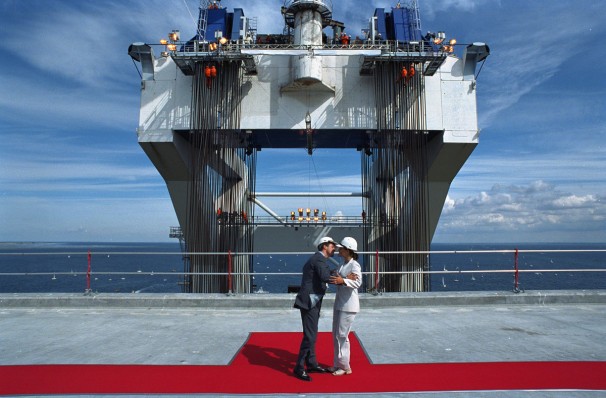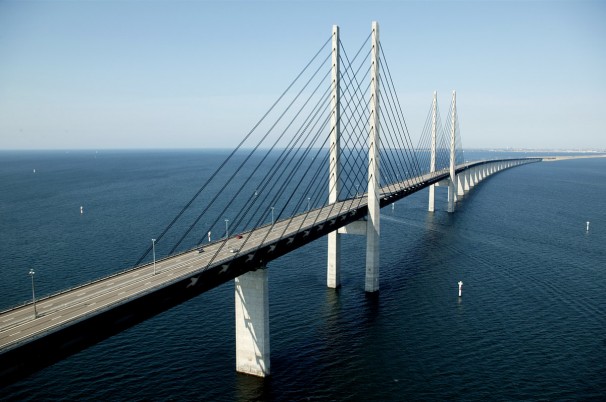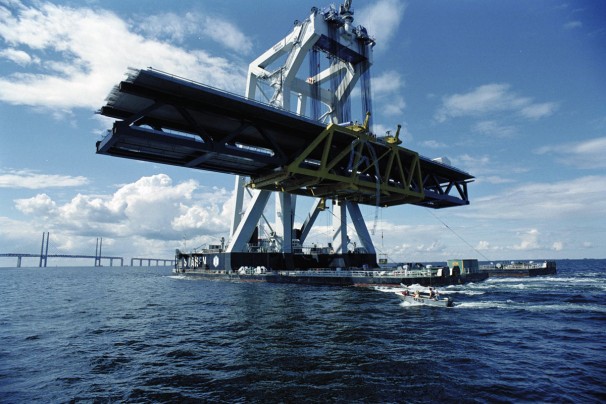Is transnational infrastructure the beginning or the end of romance?
By Iben Falconer
In 2004, the Danish band Johnny Deluxe released the video for an absurdly cheesy pop song, entitled “Drømmer Jeg [Am I Dreaming]?” The song is a duet between a Danish man and a Swedish woman who pine for each other across the Øresund Strait, a body of water that separates Denmark from Sweden.
He begins:
I stand and look out over the Øresund
Dreaming of your eyes and your mouth.
You’re in a place somewhere over there
I would swim there, if I could.
She wonders why “there are a hundred thousand miles to Copenhagen,” while he pairs the Swedish word for kiss (pus) with “radius” (pronounced in Danish, “ray-dee-oohs”). (In the song’s most cringe-inducing moment, he tells her “You are my Rachel, and I’m your Ross.”)
The pair is seen hyperactively exploring Copenhagen, kissing, smelling flowers, eating treats, and delighting in the results of a photo booth. At the end of the video, the man dejectedly sees the woman off in the city’s train station–mimicking the farewell scene of hundreds of stories.
Yet the truth of the matter is that, because of train infrastructure, Copenhagen and Malmö (Sweden’s third most populous city) are closer together than they ever have been before. In July 2000, the Øresund Fixed Link, a 16-kilometer-long bridge that joins Denmark and Sweden, was officially opened, an event that was commemorated by speeches from the Danish Queen Margrethe and the Swedish King Carl. Politicians and planners had been discussing the idea of a bridge as early as in the 19th century, yet it was not until the end of the 20th that a formal agreement was made; it was not til the beginning of the 21st that the bridge was actually completed.
While it is often referred to as the “Øresund Bridge,” the Fixed Link is actually a combination of an artificial peninsula, a tunnel, an artificial island, two approach bridges, and one high bridge that together span the almost 16,000 meters between the two countries. The link in its entirety is asymmetrical, but its three major components (tunnel, island, bridge) establish a visual rhythm under, across and over the liquid boundary of the Strait. Met on both ends by landworks of rail- and roadways, the link serves as a vital transportation corridor for the region. In the middle is an artificial island, Peberholm (Pepper Islet), the cheekily-named manmade double of an existing island, Saltholm (Salt Islet) which lies to the north. In satellite photos it resembles a spur extending from the Swedish coastline towards Denmark.
The Fixed Link was part of the European Union’s effort to build a trans-European transit network (TEN-T) to enhance transnational mobility and interoperability. A TEN-T brochure from 2002 described the benefits of the project as follows:
“With a population of 2.3 million and GDP among the highest in Europe, the region is expected to benefit considerably from improved passenger and freight connections with the surrounding Baltic countries and with European transport networks.”
But more importantly: how can a young couple in love romanticize their separation when the trip between the two countries now only takes 35 minutes? Also, why must bureaucratic language be so dull?
Thank goodness, the Scandinavian royal families came to the rescue! In Queen Margrethe’s speech commemorating the opening of the bridge, she made no mention of the European Union at all: “A supple “S” binds [us] together: Danes and Swedes […] Now we will come in steady streams from both sides, in trains and in cars. An outing to Scania is no longer a voyage. A visit to Copenhagen is no longer an exotic experience. Now we will truly discover each other. We no longer need to keep one eye on the clock and the other on the ferry schedule. We can make a quick decision: let us go over to see Malmö; let us visit a cousin in Copenhagen.” The bridge is a “dream that has become a reality.”
Her words embodied the spirit of an event one year earlier. On the morning of August 14, 1999, a crane placed the final bridge span across the Fixed Link. Later that day, the Danish Crown Prince Frederik and the Swedish Crown Princess Victoria met at the center of bridge to celebrate its completion. The pair embraced–a platonic embrace, but an embrace nonetheless.
Photographs By Pierre Mens, Søren Madsen, Pierre Mens and Pierre Mens.



